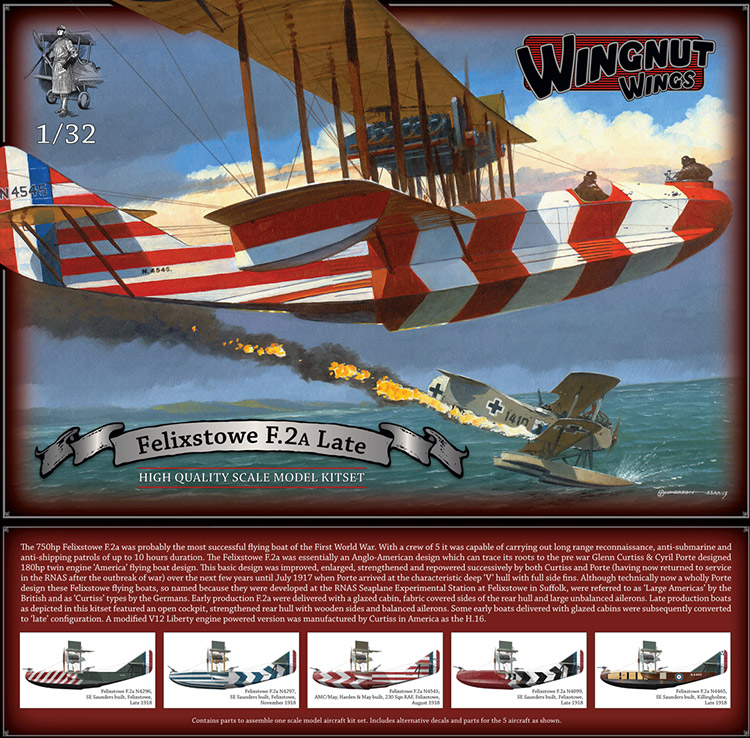 |
|
g |
|
1/32 scale Felixstowe F.2A 'Late'
Version by Wingnut Wings
Guest kit review by James Hatch as
featured in Scale Plastic & Rail, January 2015 |
| g |
|
SEAWINGS is delighted to be able to bring you this
superb kit review direct from the SP&R Website Team,
which sadly ceased operating on Tuesday 24th
February, 2015. It is as complete a kit review of
its subject that one could wish to read prior to
purchasing this fantastic model and with the demise
of the website, has now found a permanent home here
in its original glory. I could not have done any
better than this writing one myself and credit James
Hatch with grateful thanks for its entirety. |
|
|
|
gg |
|
Without a doubt, the Felixstowe F.2a series
of flying boats were some of the largest aircraft to be used
operationally during the Great War. First flown in 1916, and
becoming operational in 1917, this rather imposing looking aircraft
was actually a joint Anglo-American project which saw a new hull,
designed by John Cyril Porte, being mated to the flying surfaces of
the American Curtiss H-12. The hull itself was a large, deep
V-shaped format which was constructed from diagonally-laid planking,
and formed the basis of sea-going planes for many years to come.
This hull itself was also derived from the smaller Felixstowe F.1
series. |
|
| g |
| Powered by two 375hp
Rolls Royce Eagle VIII engines, the Felixstowe F.2a was designed to
be a maritime reconnaissance, and anti-submarine/convoy machine,
capable of carrying an explosive payload of 460lbs on external
stores below the wings. It also had a duration of around 10 hours,
which was quite remarkable for the time. The Late version machines
had a reworked upper fuselage decking which did away with the closed
cabin of the earlier version, and the rear fuselage was also sheeted
in plywood, instead of being frame and canvas. Balanced ailerons
were also introduced to the machine at the same time. Typically, the
F.2a flew with a crew of five, and was defensively armed with five
.303 Lewis guns. The 'Felixstowe' name itself was derived from the RNAS Seaplane Experimental Station, based at Felixstowe, in Suffolk,
England. Around 175 F.2 machines were built, of which about 100 were
the F.2a version. Well, I'm
absolutely, totally and truly gobsmacked. I know Wingnut
Wings like to throw surprises at us, but this surprise
is in a totally different league. The box is of course
bigger than the Gotha G.IV which we have seen, and the
wingspan of this is almost 1 metre long! You will need
some serious display cabinet space for this. These kits
are rightfully described by WNW as being their largest
yet, which could open up all sorts of possibilities if
they are to tackle other subjects too (Staaken, HP
O/400, anyone?). We have had the privilege of taking
receipt of both Early and Late versions. Today, I will
look at the Late release, while Jeroen Peters will soon
publish his look at the 'Early' kit. I still have to say
it....er, WOW!!!
Wingnut Wings' own
press-shot gives this summary of this specific kit:
1. 92cm wingspan!
2. Removable wings for
easier storage.
3. 392 high quality
injection moulded plastic parts.
4. 2 highly detailed
Rolls Royce Eagle VIII engines.
5. Late production or
converted open cabins, optional fin tops, rear hull
sides and balanced & unbalanced ailerons.
6. Beaching dolly and
trestles for diorama display.
7. 47 photo-etched
metal detail parts.
8. 36 page fully
illustrated instruction manual.
9. High quality
Cartograf decals with markings for 5 spectacular
aircraft.
As I have just said,
this is a very large box, and if you have a plastic
habit, then what you'll see here should provide you with
a seriously long-lasting fix. You don't usually
associate British aircraft with colourful schemes. It's
true to say that we were rather staid, in comparison to
the Germans, for instance. However, this box art dispels
that notion totally. Some of the larger, and more
vulnerable aircraft had disruptive camouflage applied to
them, much in the same manner that a number of ships of
the time had. Steve Anderson has created a stunning
image of a machine operating in a red and white
disruptive scheme, having just engaged and destroyed a
Hansa-Brandenburg W.12.
Without a doubt, the most imposing release we've yet
seen from Fortress Wingnut. Now my hands have stopped
shaking, let's look at this release a little more
closely.
There are ELEVEN,
individually bagged sprues moulded in light grey
styrene, and ONE small, clear sprue in this release.
Some of those sprues are also VERY large, and with
almost 400 parts, you are certainly going to have your
work cut out with this project in more ways than one.
This kit also contains a single photo-etch fret, and 3
decal sheets of varying sizes. This time though, you
will be expected to mask and airbrush those elaborate
stripy markings, unlike the decals which were supplied
for bands/stripes in the smaller, fighter kit releases.
It just isn't realistic to provide them for a bird this
size, and it would have pushed the price up further.
Having said that, masking the model will be pretty
simple, as these schemes aren't at all awkward to
realise. Definitely no more difficult than a regular
camouflage scheme.
WNW's largest
instruction manual is also included here too. We'll look
at that more closely in the later stage of this article. |
|
|
g |
 |
 |
| g |
| In keeping
with previous releases, this sprue contains a good number of
internal parts, concerting the rather large cockpit and crew
areas of this behemoth. All parts on this sprue are also
slated for use with this 'Late' version. We all know that
building WW1-era models means that you have to employ a few
new tricks to your techniques arsenal, and here you will
need to make serious use of whichever method you use for
wood-graining. The complicated-looking side wall frames, and
the duckboard style crew area floors are the main candidates
for this, and impressive they are too. Those sidewalls are
provided in halves, such is their size. Other wood grain
recipients are the bulkheads, detailed instrument board,
sub-deck for fuel tank mounting, alleyway decking which
connects the forward crew areas to the rear, and also
numerous other structures such as the wireless reel pole and
rear spar/engineers instrument board etc. |
|
| g |
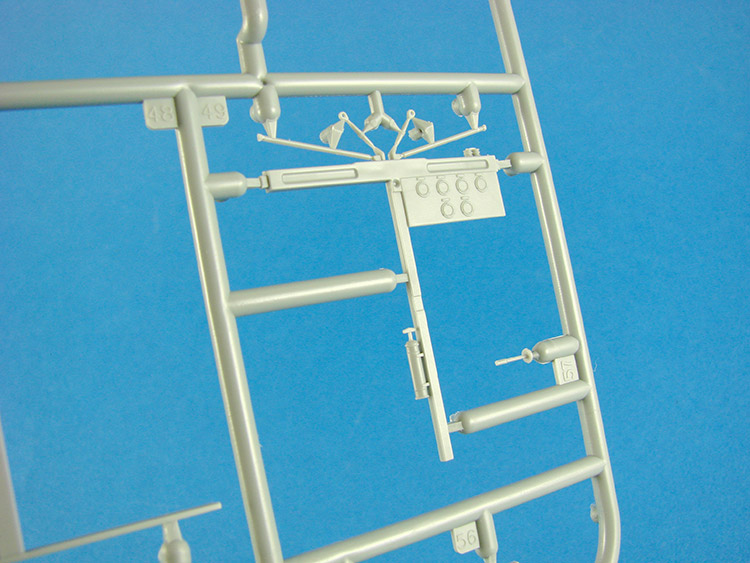 |
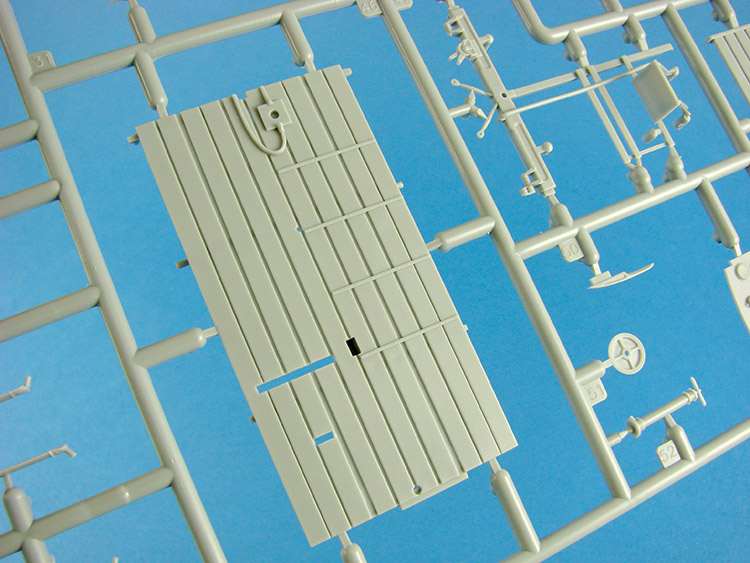 |
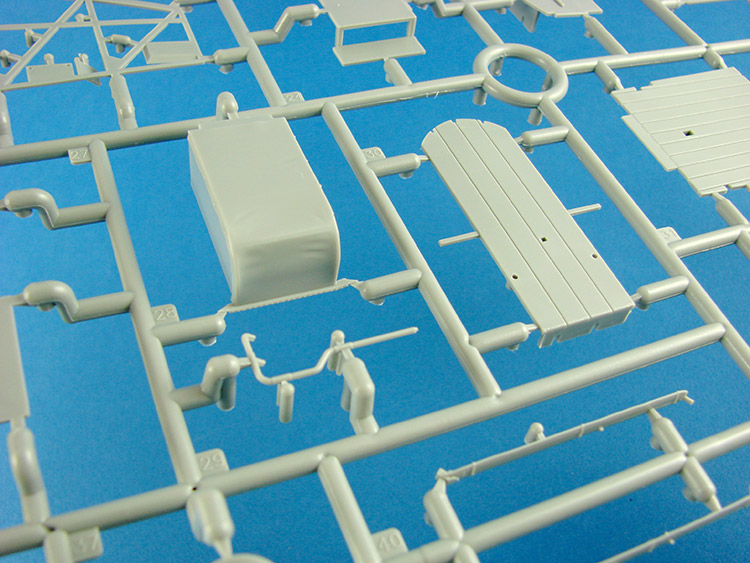 |
 |
| g |
| I've
always said that for me personally, the cockpit it
probably the most fun and challenging part of a build,
and this particular one very much excites me. By no
means are all the internal parts moulded on this sprue.
The sheer internal detail prevents this.
On this
sprue, you will find such parts as the wireless cabinet
(with moulded-on waterproof tarpaulin), multipart crew
seats, fuel tank stirrup pump (assuming it's not for the
bilge), engineers ladder, engine control quadrant,
control column ensemble for the dual wheels, fuel pipe
runs etc. You will also find the exterior centre section
duel strut part, but for this Late version, you will
need to cut away some plastic which runs between the
struts, leaving only the fuel pipes as the
interconnecting detail. Please be careful here, as this
part will be very vulnerable until you come to fix it to
the model. The frameworks for the wind-driven petrol
pumps, and the tail skid are also to be found here. |
|
| g |
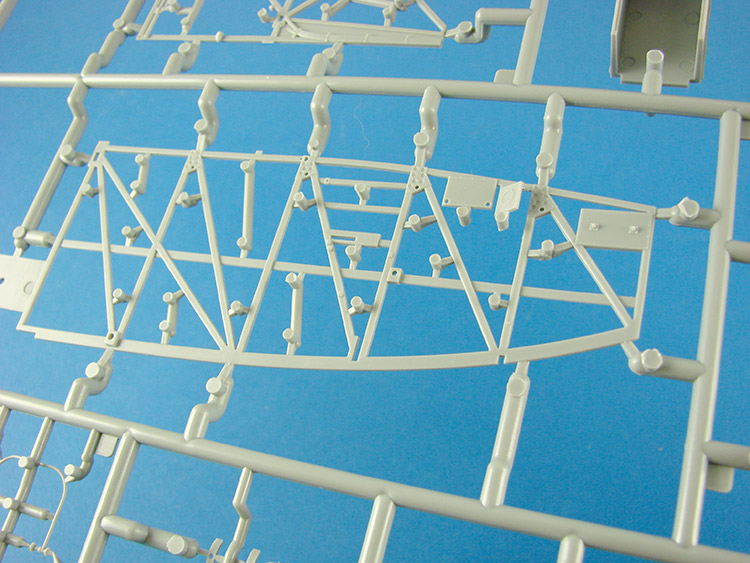 |
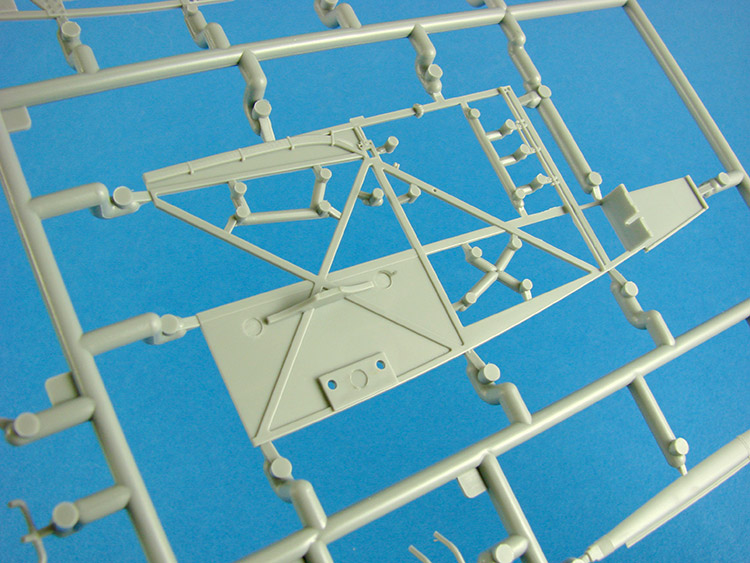 |
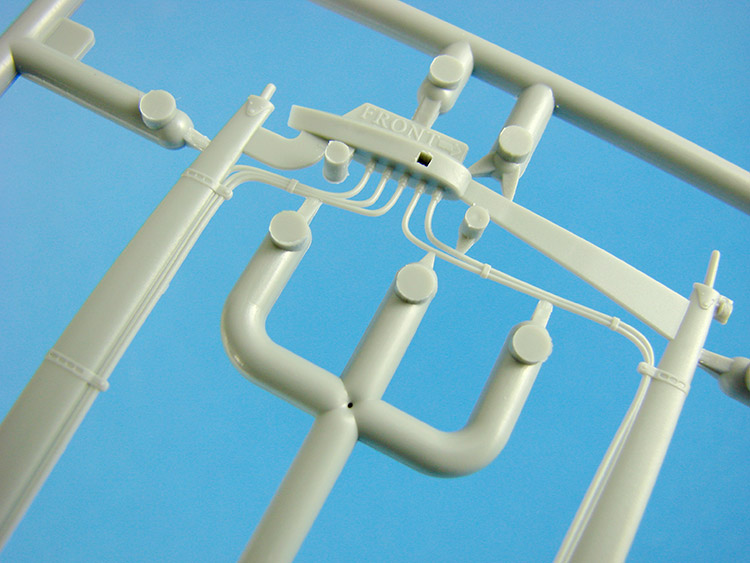 |
 |
| g |
| Detail
is outstanding. The floor planking. The instrument board
detail (to be supplemented with instrument decals). The
side walls. Basically everything. Ejection pin marks are
either thoughtfully placed on the rear of the parts, or
on small tags which you will snip from the various finer
frames etc.
I can tell
you that when it comes to internal rigging, this model
has plenty. Make sure you stock up on your turnbuckles
for this. You will need to rig three separate entities
here: engine control cables, ailerons/elevators & rudder
cables, and also the structural bracing. |
|
| g |
 |
 |
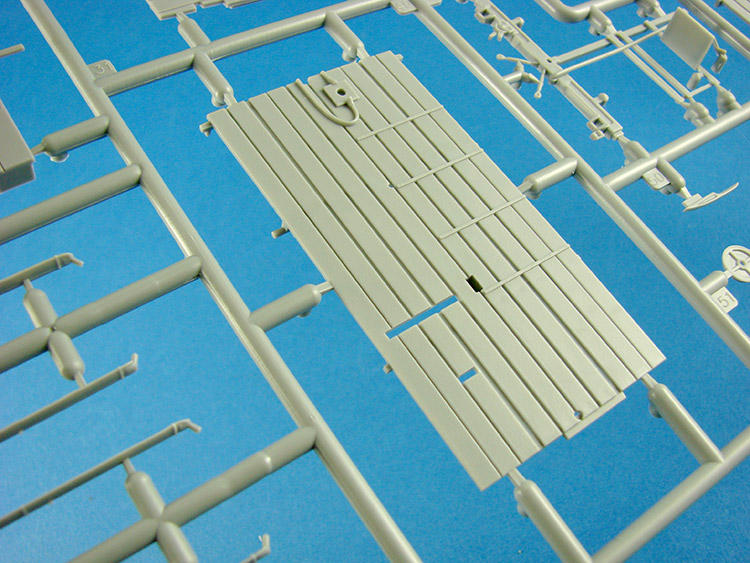 |
| g |
 |
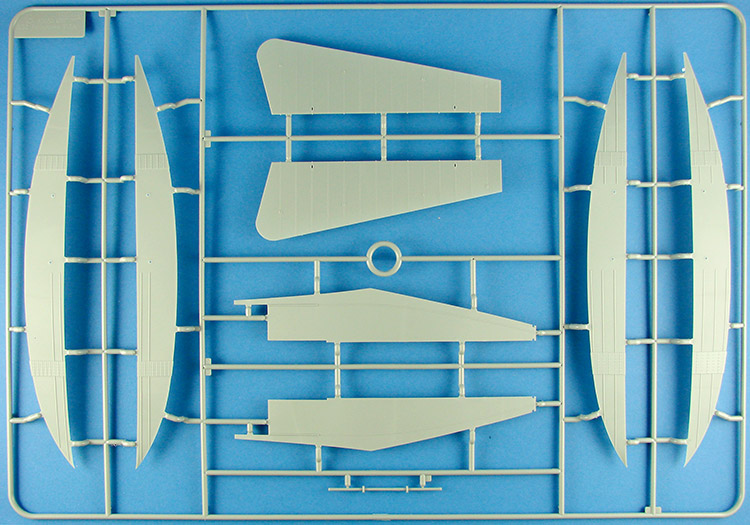 |
| g |
| As you
will have read from my introduction, the Late machines
had a plywood sheathed rear fuselage. That was a
generalisation, and some machines operated with the
regular doped linen panels. One of the schemes in this
kit will use that particular format, but the others will
indeed use the plywood sheathed fuse. WNW has designed
this kit to utilise the same basic fuselage main parts,
and these rear panels are separate pieces which are
included on this sprue. There isn't too much detail
here, by design, and again, all ejector pin marks on
these large pieces are inside the model, and well out of
sight. What raised external detail there is will need to
be sanded away. |
|
| g |
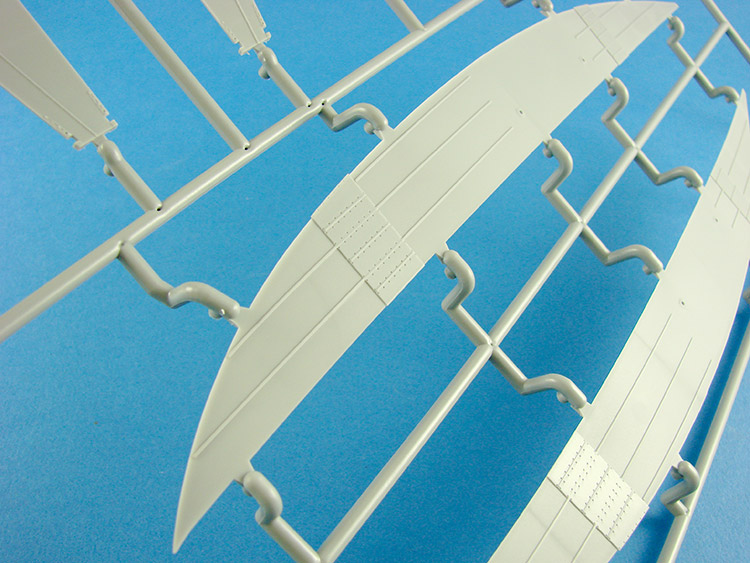 |
 |
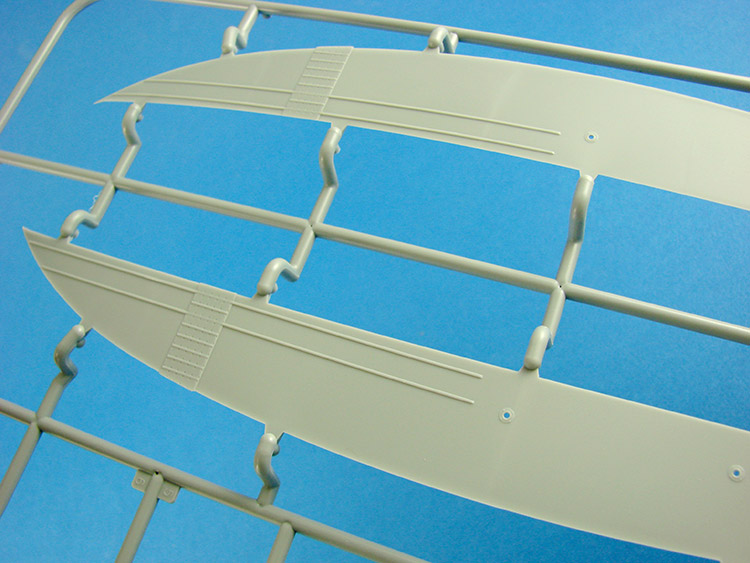 |
| g |
| The
other float-shaped parts are actually part of the hull.
These form the fine which run along the upper face of
the v-shaped hull which is slightly wider than the
overall fuse width. There are two options here which
have different numbers of timber baton strakes, and one
of these will need a baton sanding away too.
If your
machine wasn't yet fitted with the balanced ailerons
(Schemes A & B), then the unbalanced ones are to be
found here. These large pieces have excellent rib and
fabric cover representation, and nice clean holes for
the rigging levers/horns.
There
is only one other part included on this sprue, and that
is for the axle on the beaching trolley. |
|
|
g |
 |
 |
| g |
| This
small sprue contains just FOUR parts. These are for the
two windshields that replaced the main canopy of the
'Early' type. Two options are supplied here for either
rounded or square windshields. Clarity is excellent, and
of course, very little to mask when it comes to
painting. |
|
|
g |
 |
 |
| g |
| These
sprues contain a multitude of parts, both external and
internal. Within the interior, you will find the petrol
tanks and their respective plumbing, ammunition bins and
drums as well as the Lewis guns themselves and their
mounts, steering wheels, rudder pedals etc. Whilst the
various interior areas have quite a reasonable parts
count, it isn't too cluttered, and you will be able to
see many interior areas and equipment through the
various hull openings. |
|
| g |
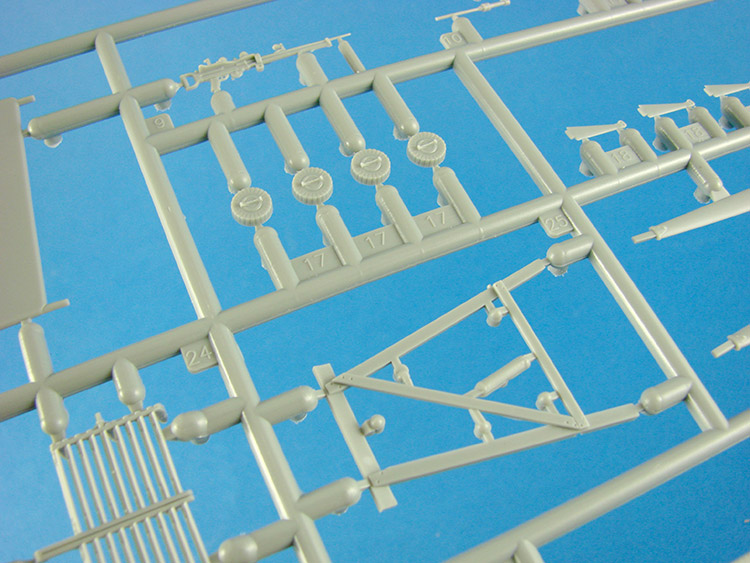 |
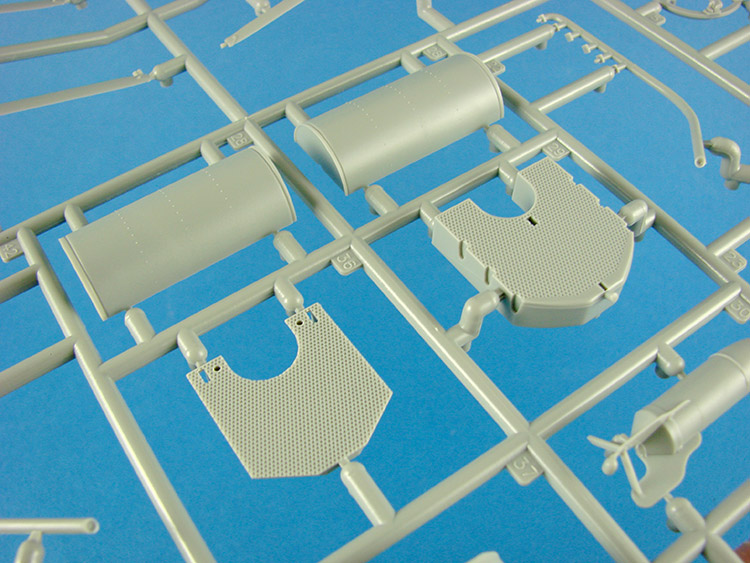 |
 |
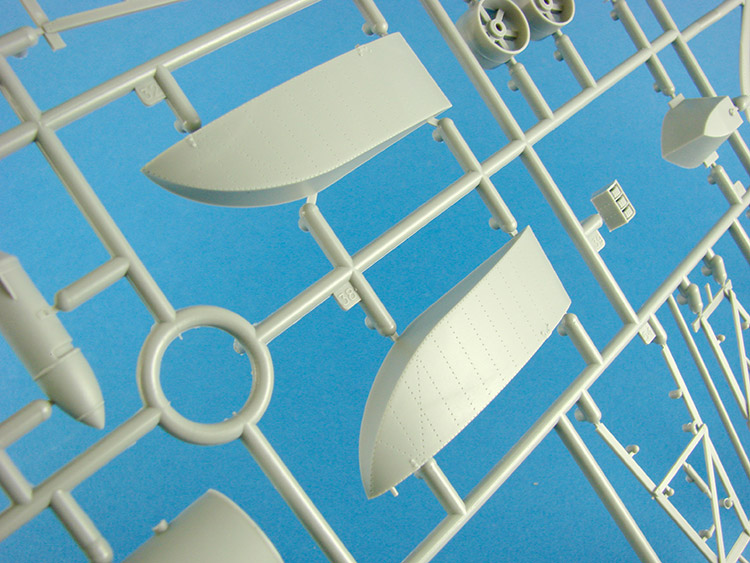 |
| g |
| A
number of parts here are associated with the Rolls Royce
engines, and these are the water cooling plumbing which
sits below the engine chassis, elegant four blade
propellers, radiators and shutters (superbly moulded
open louvre work), oil tanks, and also the inter-wing
strut/engine mounting frameworks. I have to single out
the design of these as being exceptional. Essentially,
they are moulded as port and starboard side which are
glued together, along with the oil tank assembly and a
spreader bar. The engine simply then sits in this
framework, and then the radiators etc. are installed.
This is a very clean solution to what could have been a
complicated problem. Once installed, the exhaust and
water pipes can then be fitted, before the whole
assembly is transferred to the model. At this point,
it's seriously important that the secondary lower struts
from Sprue A are added, to create a sturdy platform for
both engines. |
|
| g |
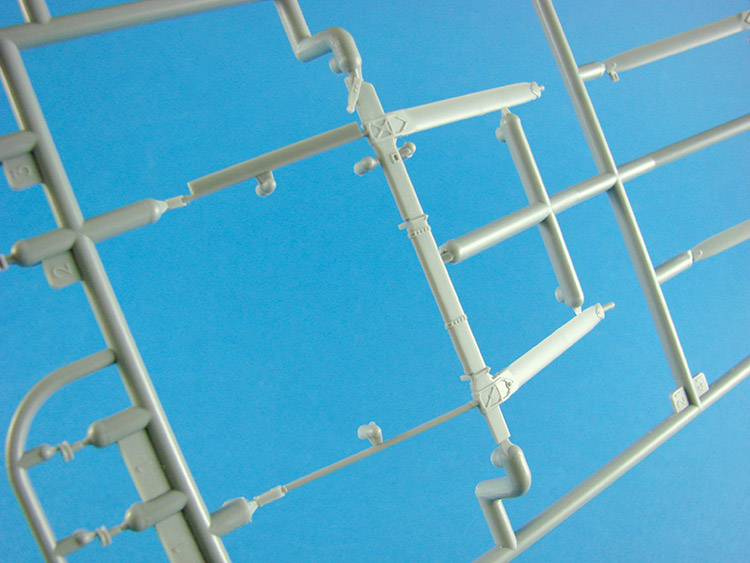 |
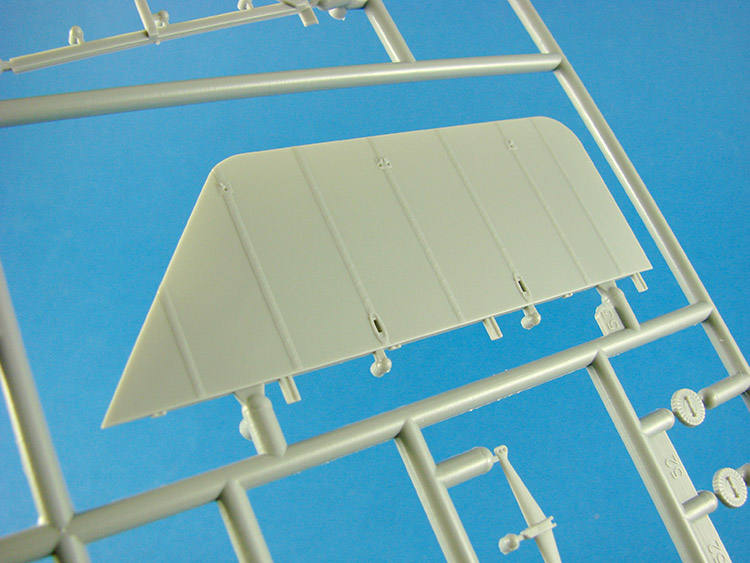 |
 |
 |
| g |
| Other
parts you will see here are the beautifully detailed two
part wing tip floats, general wing struts, vertical wing
stabiliser, aileron control cable pulleys, Lewis gun
scarff ring, bombs and racks and trestle parts for both
the aft hull and wingtip floats.
This is a
pretty busy sprue which will see personal service
throughout the build of the Felixstowe. |
|
| g |
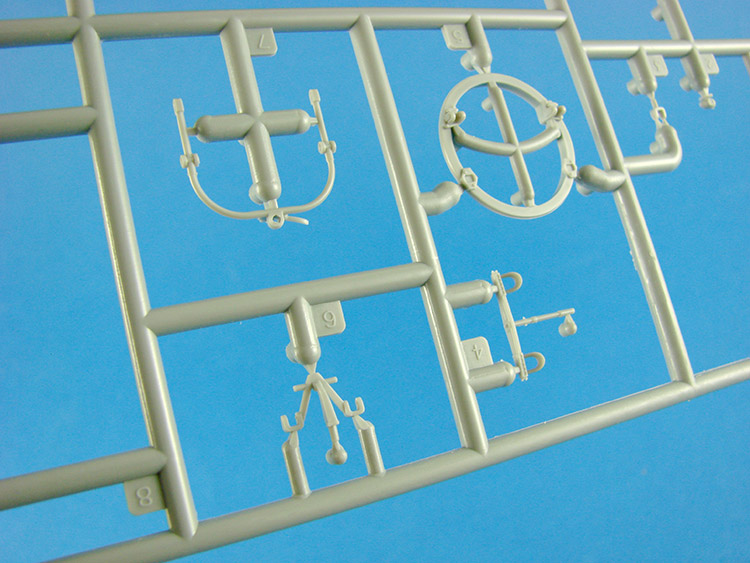 |
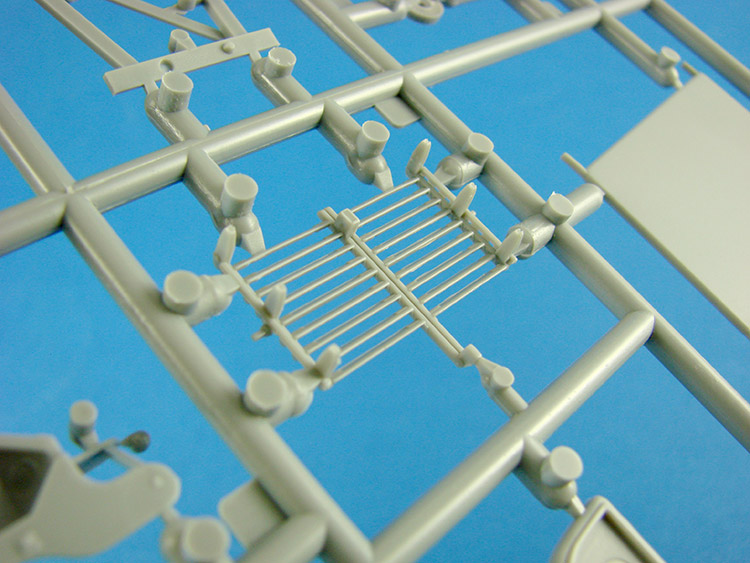 |
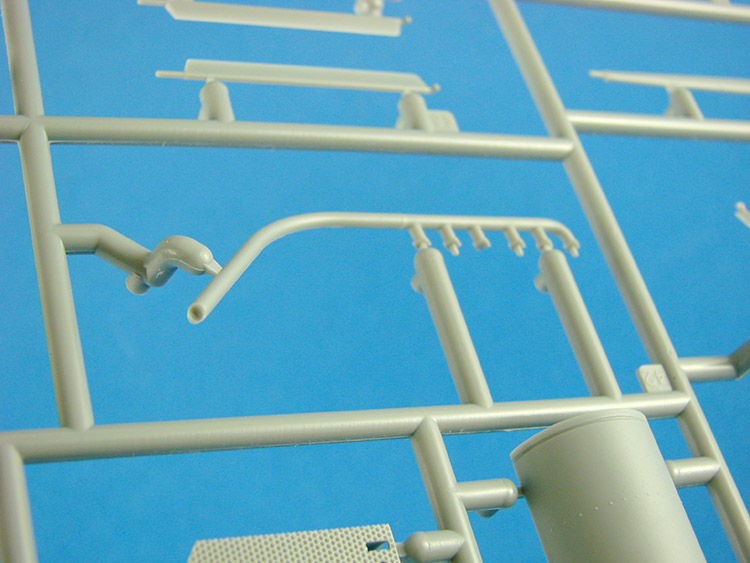 |
| g |
 |
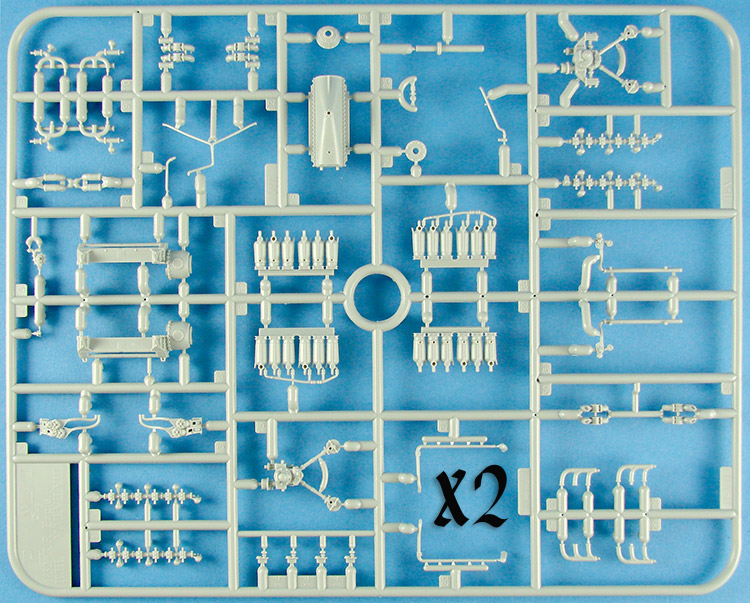 |
| g |
| Two
engines means two sprues, and here you will find all
parts associated with the common 12-cylinder Rolls Royce
Eagle. This engine is a mini-masterpiece with some of
the finest detail I've yet seen on a WNW kit. Each
cylinder bank is supplied as halves, and these fit to a
three part crank case and sump assembly. Those cylinder
banks are fitted with separate rocker heads, water pipes
and carburettor intake pipes. The latter will connect to
the Claudel-Hobson carburettor which fits to both front
and rear of the engine. |
|
| g |
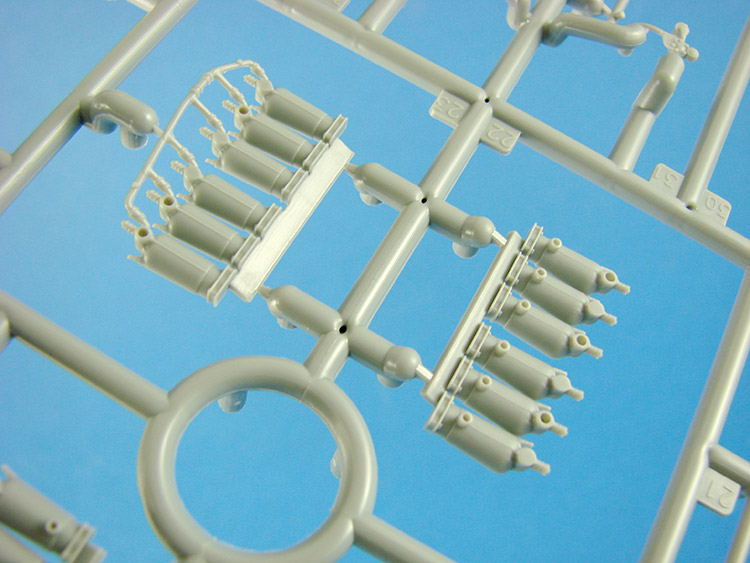 |
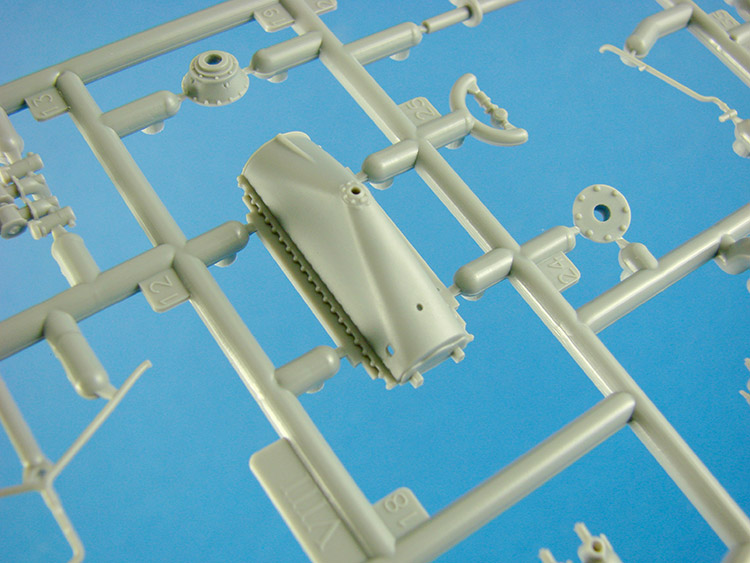 |
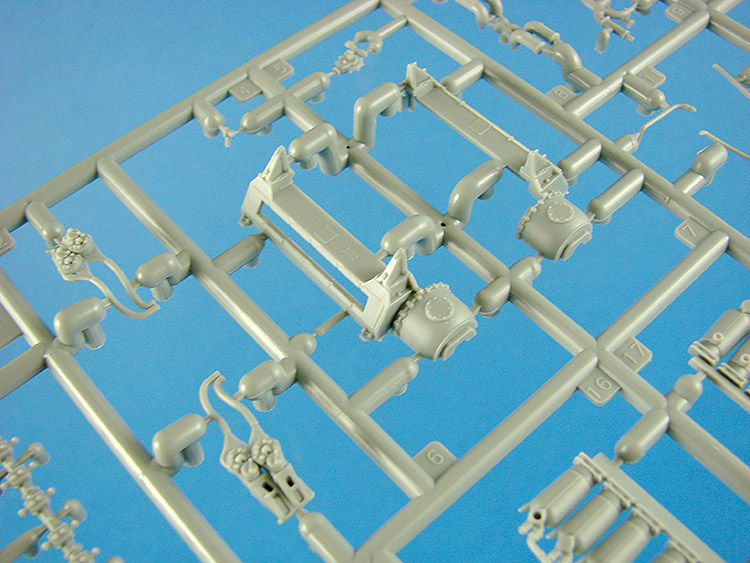 |
| g |
| The
Watford magnetos are moulded with their wiring detail,
and this will correctly locate to the sockets which fits
in between the magnetos. In total, there are around 30
parts to each engine, not including the supplementary
fittings which will installed specifically for the
Felixstowe. |
|
| g |
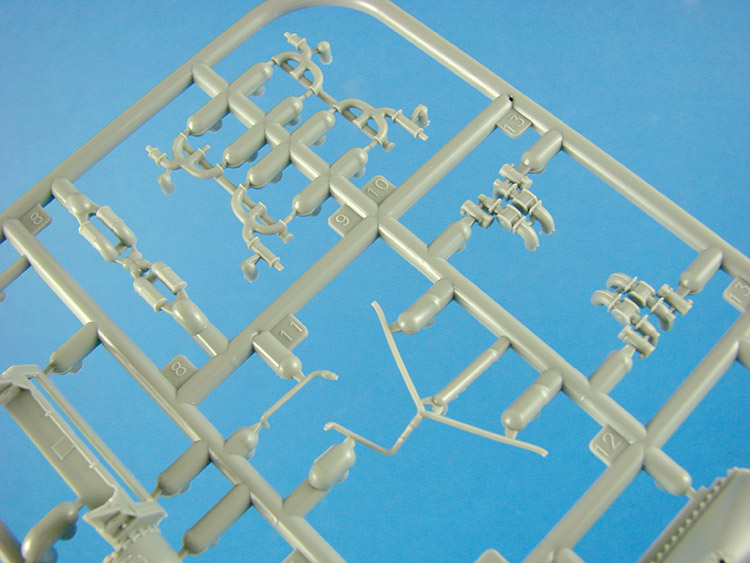 |
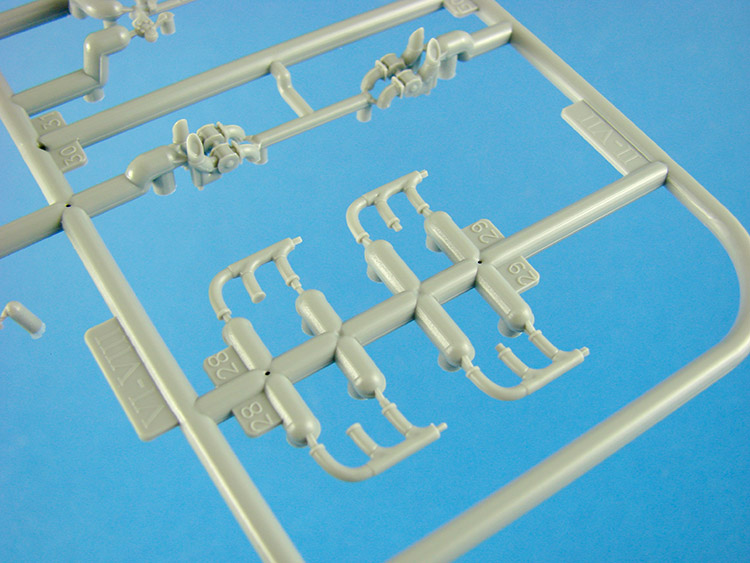 |
| g |
 |
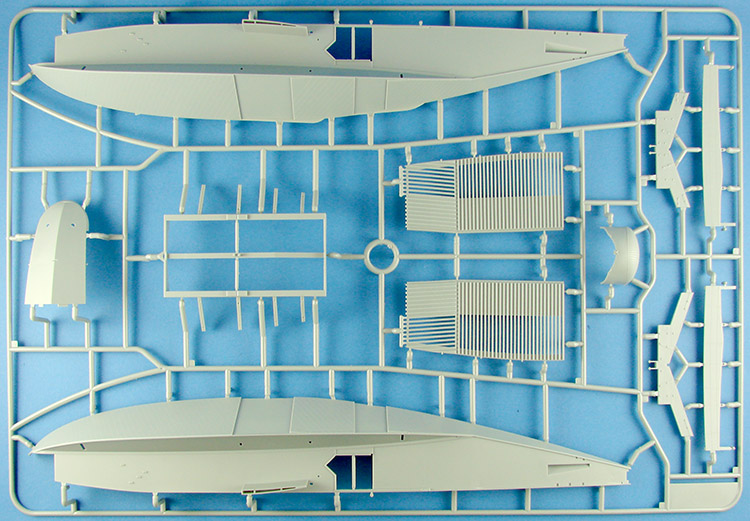 |
| g |
|
Another large sprue, but one that contains one of the
big events of this kit; the fuselage/hull. You still
can't even begin to grasp the sheer size of this model,
even with this, as the wings are disproportionately
longer than the fuselage/hull of this model. Externally,
you can see the rear fuselage recesses into which your
preferred choice of plywood or fabric panel will fit,
and of course the V-shaped hull and the protruding fin
which sits atop it. Upper hull detail is sparse due to
the nature of the plywood skinning, but the lower
sailing hull exhibits the diagonal planking which was
used to construct the vessel. Also note the side
openings through which the Lewis gun will protrude.
Detail within the hull is sparse due to this being the
almost exclusive remit of the cockpit and internals tub
that you will insert within. Note the lower wing
shoulders that are moulded onto the exterior. This
provides a solid and accurate base for this work. |
|
| g |
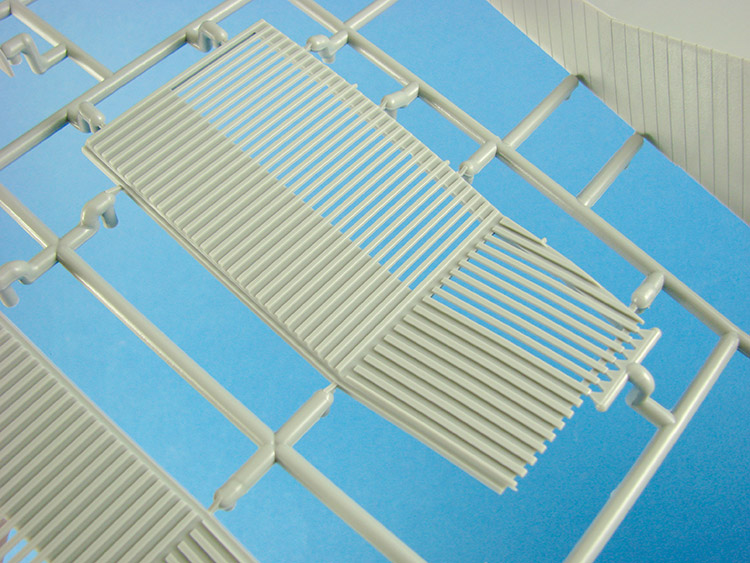 |
 |
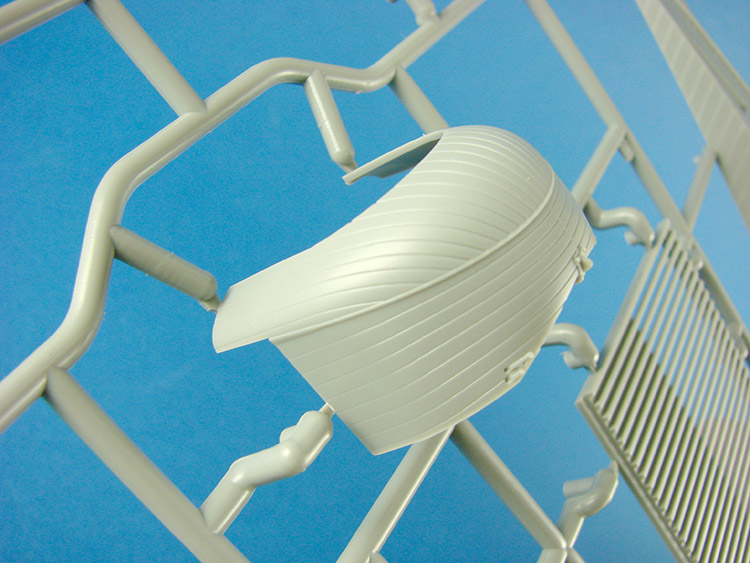 |
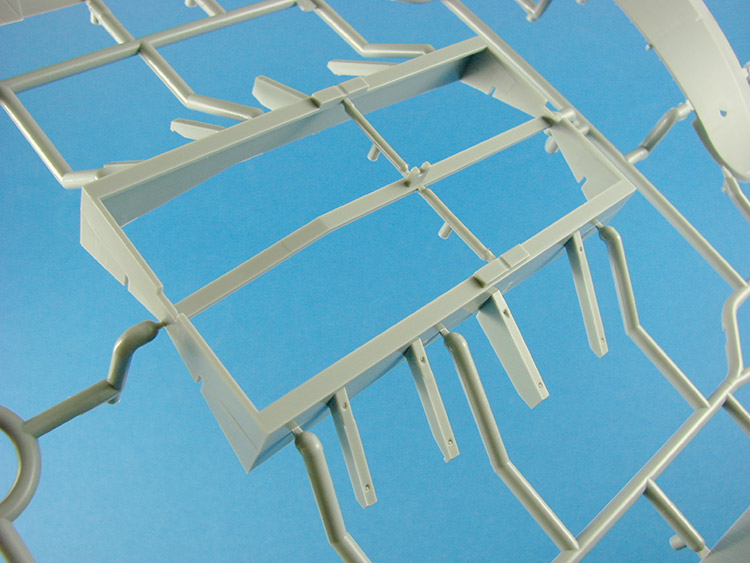 |
| g |
| One
part on here forms the internal floor area for the bow
of the hull. This would've been difficult to achieve any
other way, and of course provides a much simpler way of
painting and finishing this area. There are two external
bow sections to choose from, dependent on scheme, and
one of them is included here, again with timber planked
external finish. This section is for the converted early
production machine. |
|
| g |
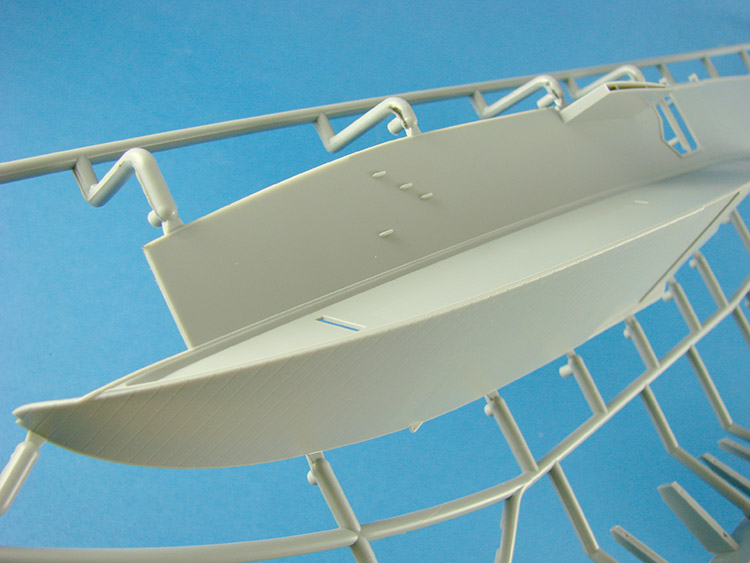 |
 |
 |
 |
| g |
| A
monster-sized seaplane needs a monster-sized beaching
trolley, and the main components are to be found here.
The framework consists of sturdy looking timber
frameworks with massive bolt-heads holding the sections
together, and also two large duckboard style plates upon
which the hull will sit. Again, detail is excellent, and
this will look great with some dark weathering and
perhaps a little green algae effect paint applied. |
|
| g |
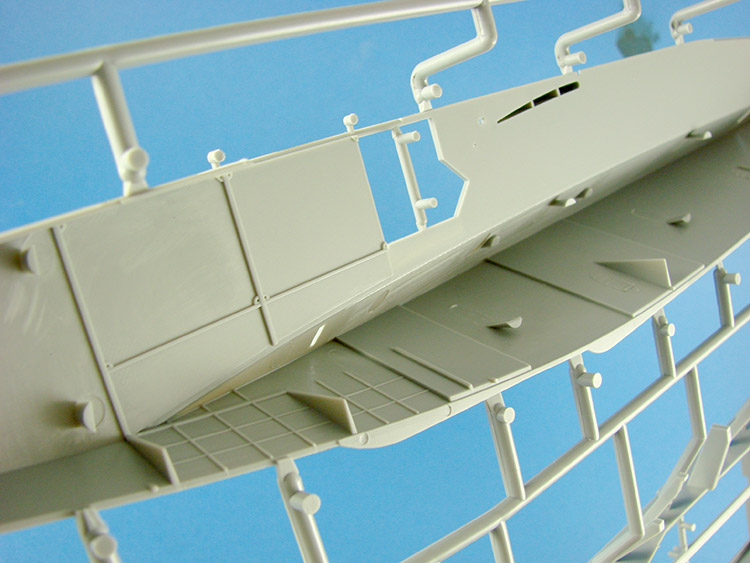 |
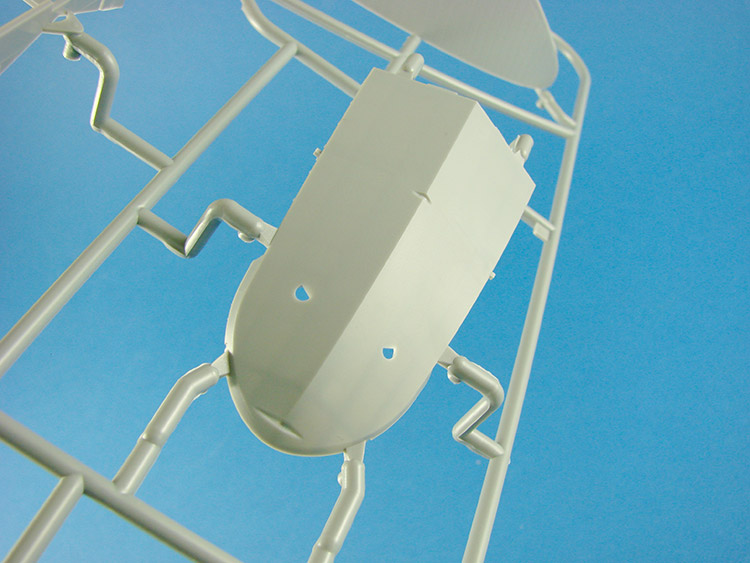 |
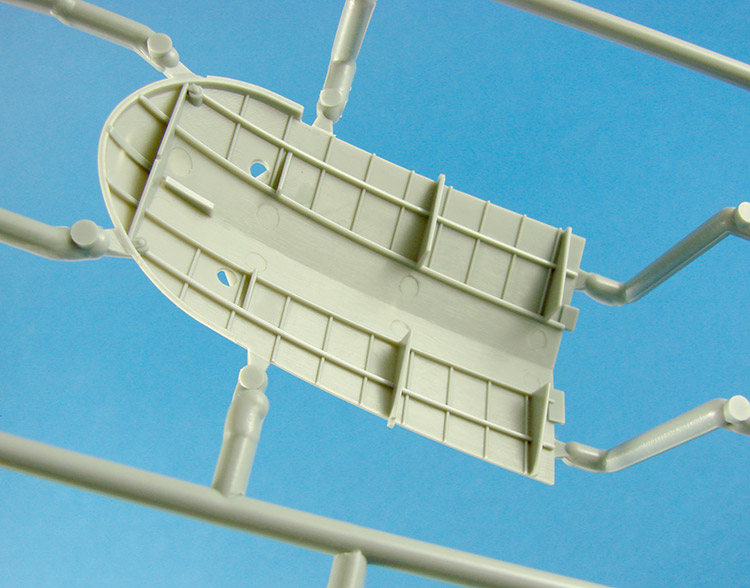 |
| g |
 |
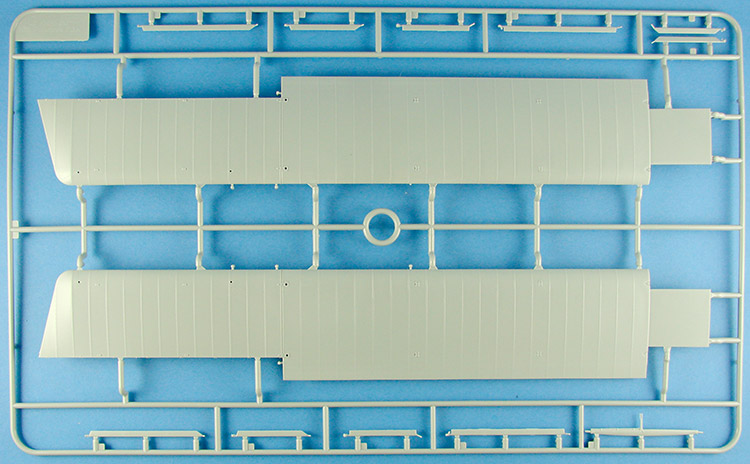 |
| g |
| For
such a large aircraft, the wings had a remarkably narrow
chord. Here we see both outer, upper wing panels. At
this point it's worth telling you that WNW has designed
this model so that both upper and lower panels can be
detached, complete with rigging. This of course aids
storage and transportation. Rib and fabric
representation is very authentic, and strut attachment
points are quite deep. As all struts are identical,
there's no need to employ the various-shaped holes that
we've seen on some WNW releases. To use the balanced
aileron option, you will have to slightly shorten the
outboard tip slightly. This is clearly seen in the
manual. |
|
| g |
 |
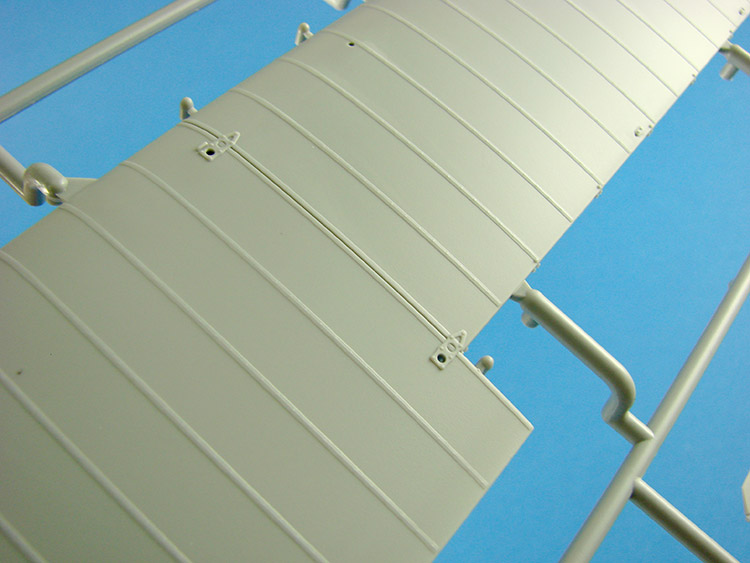 |
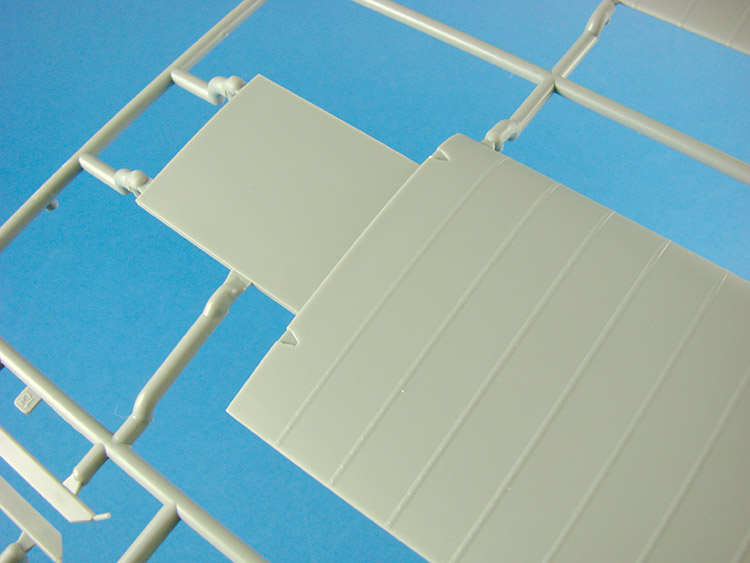 |
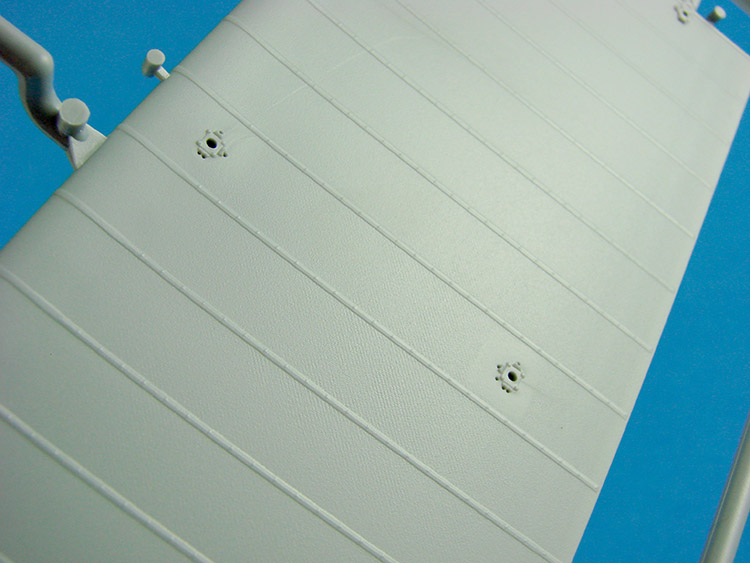 |
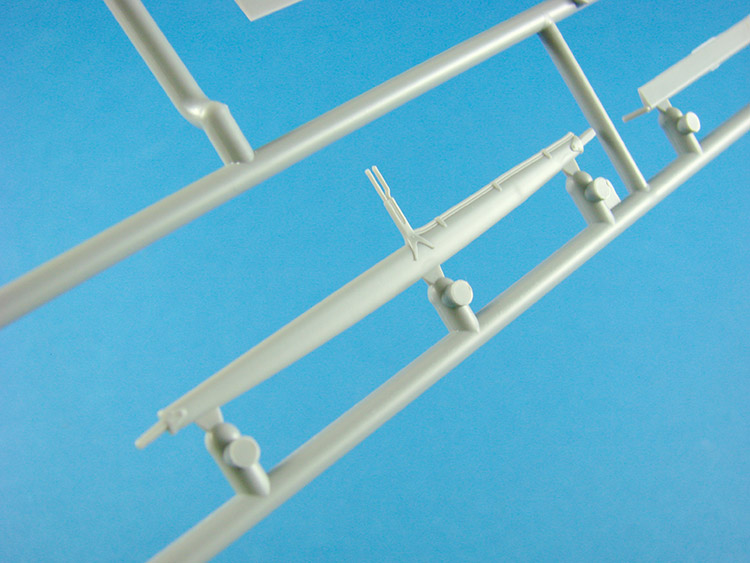 |
| g |
| Other
parts on this sprue are for the numerous stabiliser
struts. |
|
| g |
 |
 |
| g |
| Now
it's the turn of the lower wings. Here we see them
moulded with the same finesse as those on Sprue G.
Attachment to the hull wing shoulder is via a very solid
tab. Those wing shoulder parts are also moulded here.
These parts, as well as the centre-upper wing section
are moulded as solid, two-piece items for which the only
hollow areas are to insert those tabs. |
|
| g |
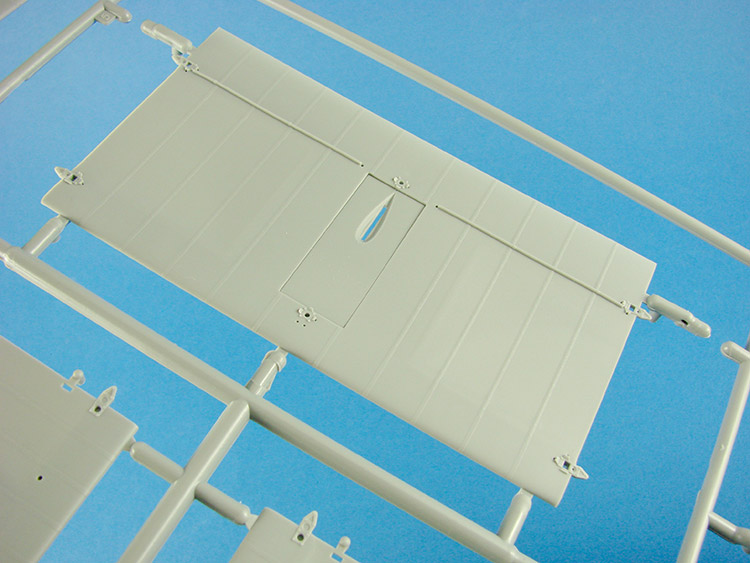 |
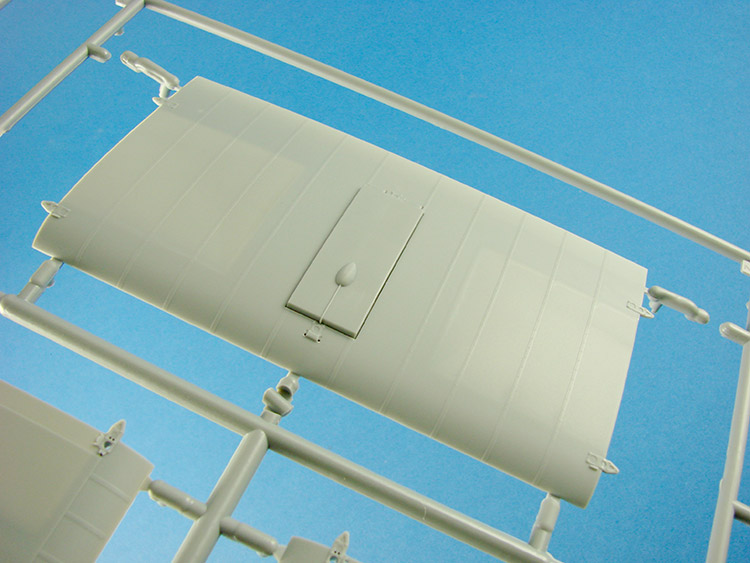 |
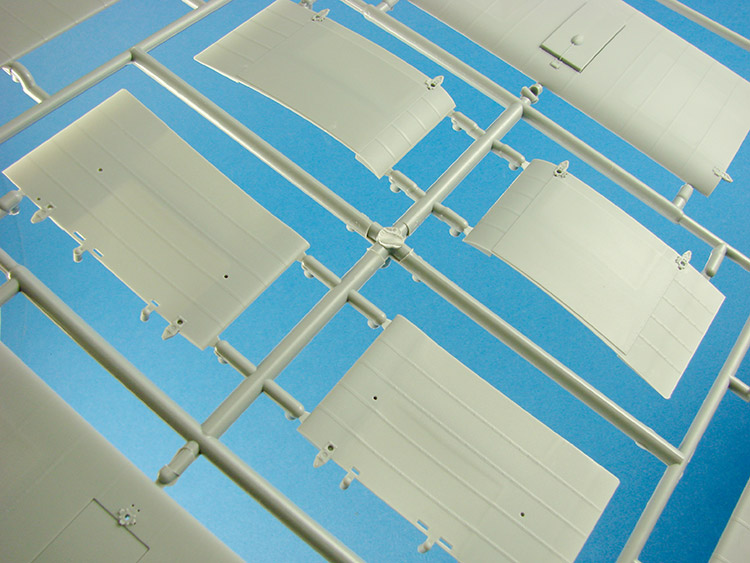 |
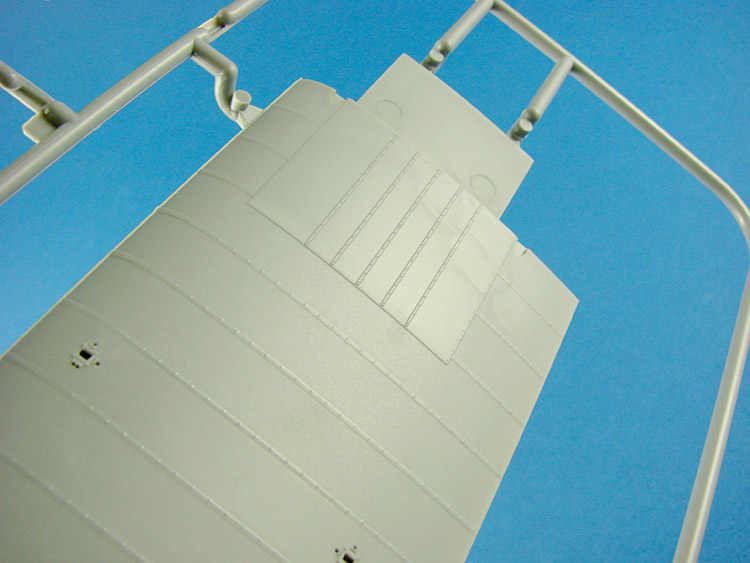 |
| g |
 |
 |
| g |
|
Although not for use, the intriguing thing about this
sprue is the single four blade propeller. Perhaps it
won't be long before we find out. This sprue mostly
concerns itself with the sizeable tail plane. The fin is
moulded as a single part, onto which the upper, full
span stabiliser slots and is supported by a rigid tab
assembly. Each underside wing panel is then glued into
position, as well as the rudder. Surface detail is
excellent, and this looks to be a straightforward area
of assembly. |
|
| g |
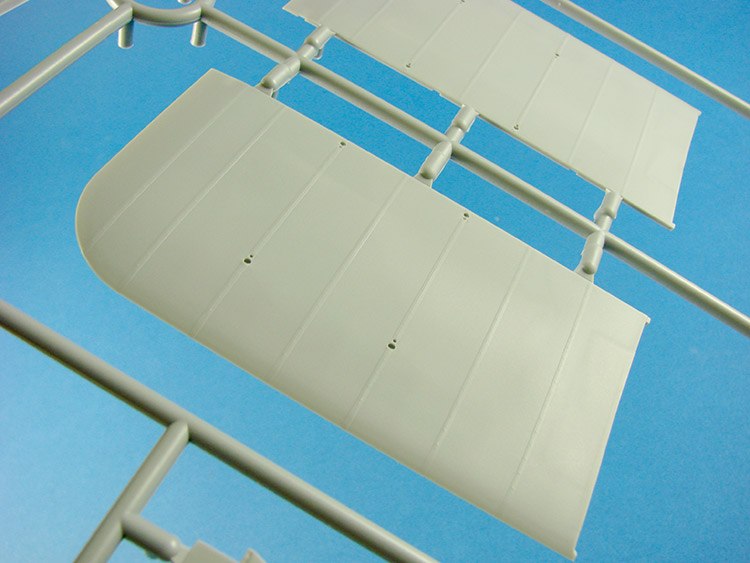 |
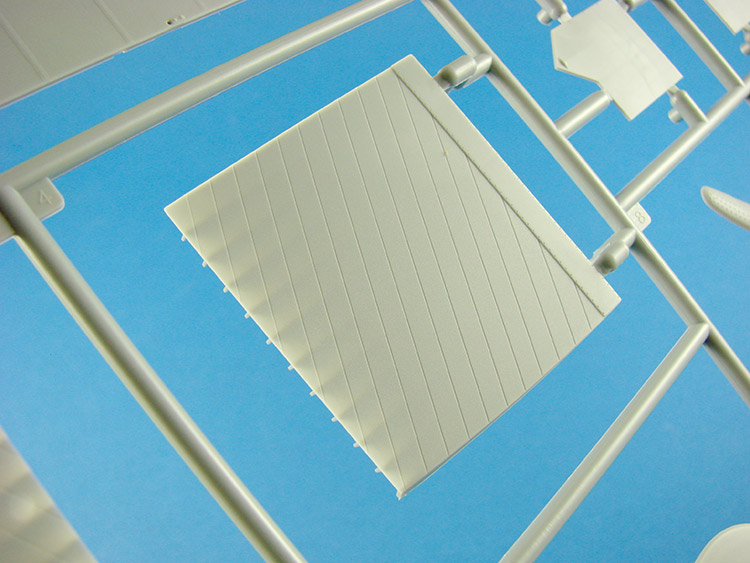 |
 |
| g |
| Two
sliding doors are provided for the hull waist gunner
positions. Nice to keep you shielded from any inclement
sea weather and spray. These have neat internal
structural detail.
Lastly,
raised sections of the lower hull underside are
separately moulded here. I feel these were the
reinforced sections that the beaching dolly needed to
sit against. |
|
| g |
 |
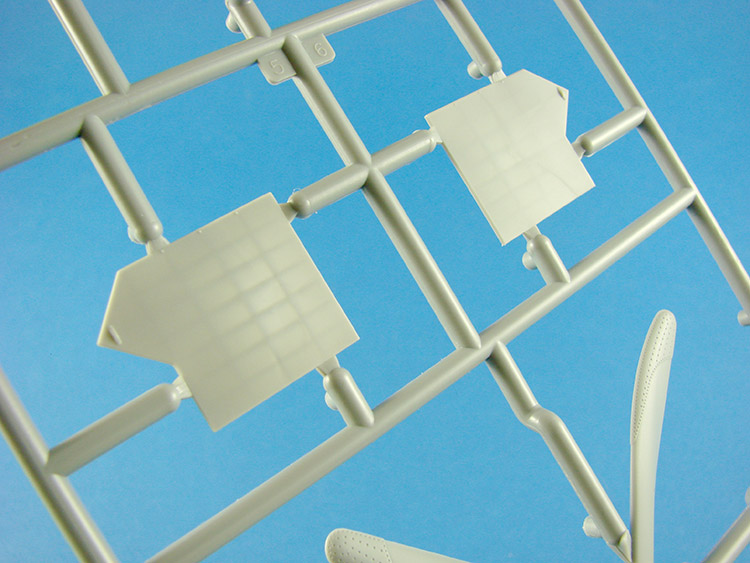 |
| g |
 |
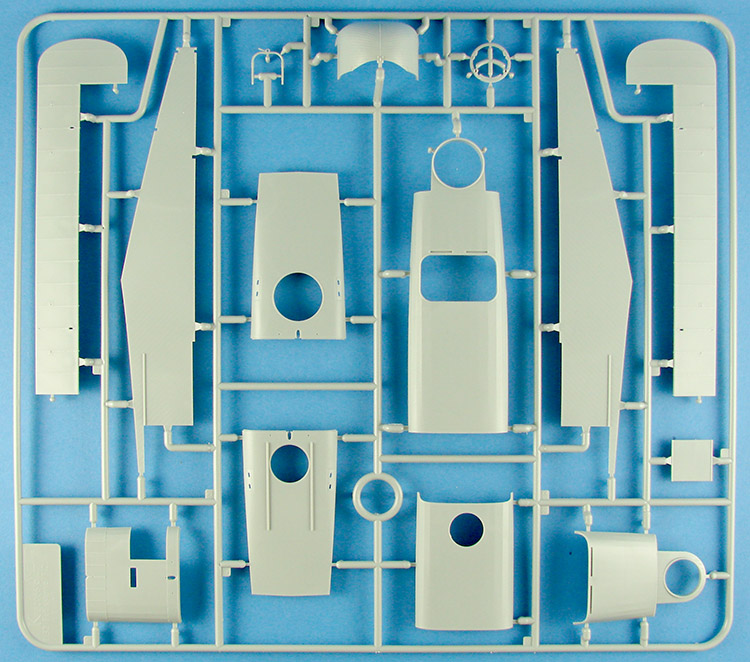 |
| g |
| This
last plastic sprue contains a large number of key
external parts. Firstly, if you choose to model your
Felixstowe with balanced ailerons, then you will find
them here. On the other hand, if you wish to depict the
fabric rear fuselage of the earlier machines, then this
insert part is included here too, complete with a subtle
fabric weave effect. |
|
| g |
 |
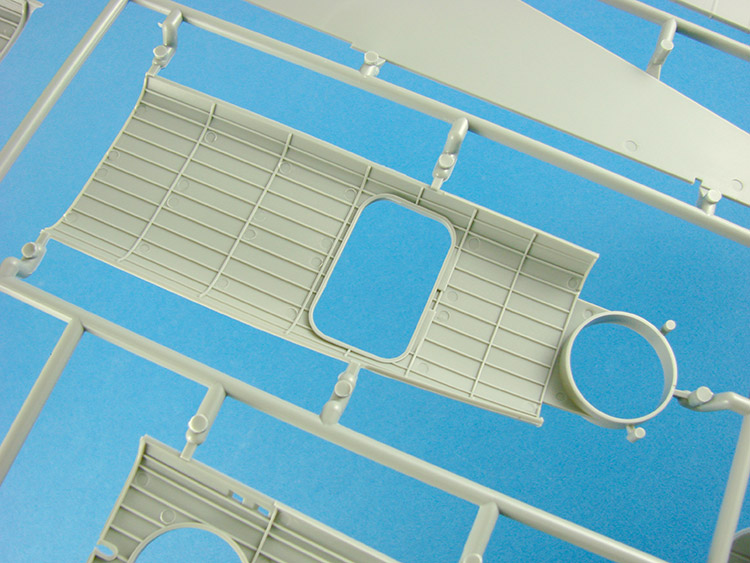 |
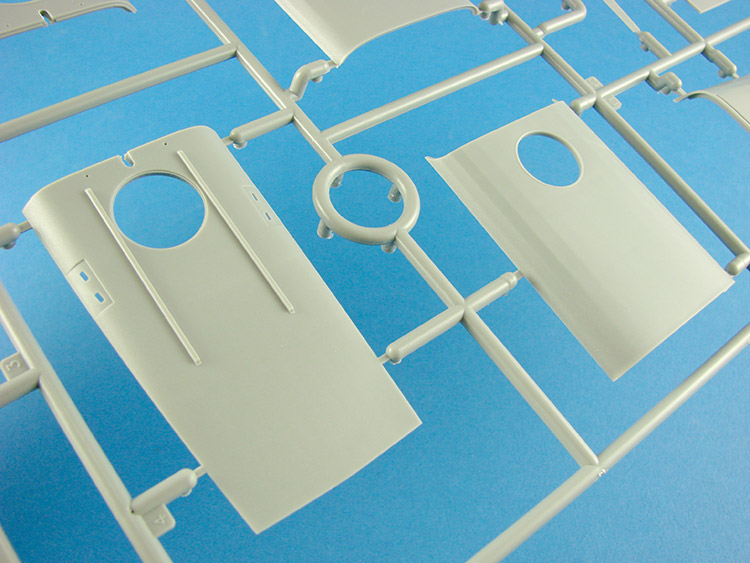 |
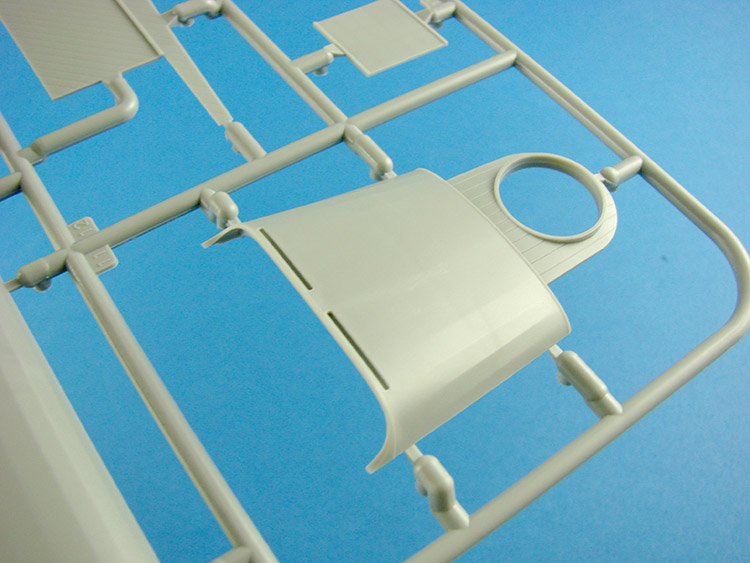 |
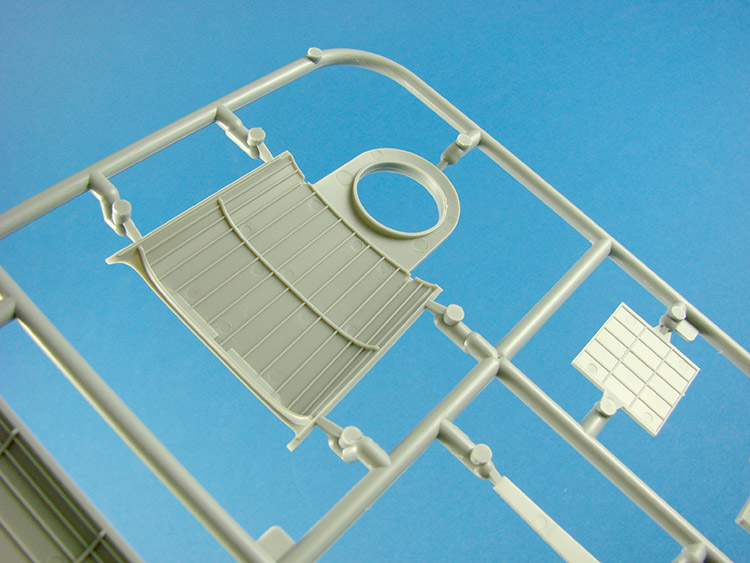 |
| g |
| A key
difference between the early and late machines was the
change to the upper fuselage/hull. This sprue supplies
both the converted early upper decks which were more or
less changed to late production style, and also the
actual late production type. These decks were stringer
with fabric covering and this is nicely depicted here.
Internally, that stringering, along with the frames, is
neatly moulded, and ready for your neatest painting
attention!
For the
late production machine, a new bow is supplied, with
subtle changes over the early machine part. For this
part, a Lewis gun mounting ring is also supplied. A
sliding door for the rear, upper opening is moulded
here, applicable to the late production machines. No
such luxury for the early converted machine. |
|
| g |
 |
 |
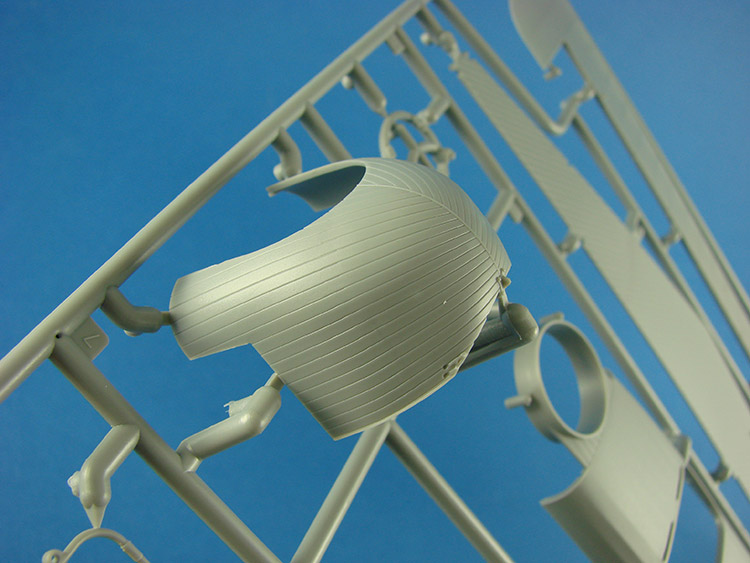 |
| g |
|
Plastic summary
- Just perfect.
No
visible sink marks or other flaw can be seen, and seams
are virtually impossible to see. Ejector pin marks are
either totally hidden or are situated on small tags
which you will snip off the parts. The tiniest bit of
flash can just be seen on the odd louvre etc, but
nothing too much. |
|
| g |
 |
 |
| g |
| As
with all Wingnut Wings kits, metal belts are included
for all crew positions, and also the addition of a
backrest for the second pilot. This is a bird with a lot
of rigging, and some cables pass though the same point.
For this, cable brackets are included, helping to keep
everything neat and tidy. Other parts on this fret
include parts for the Lewis gun mounts, lick plates for
the crew steps, gun sight reticules, etc. Production is
excellent, as always. |
|
| g |
 |
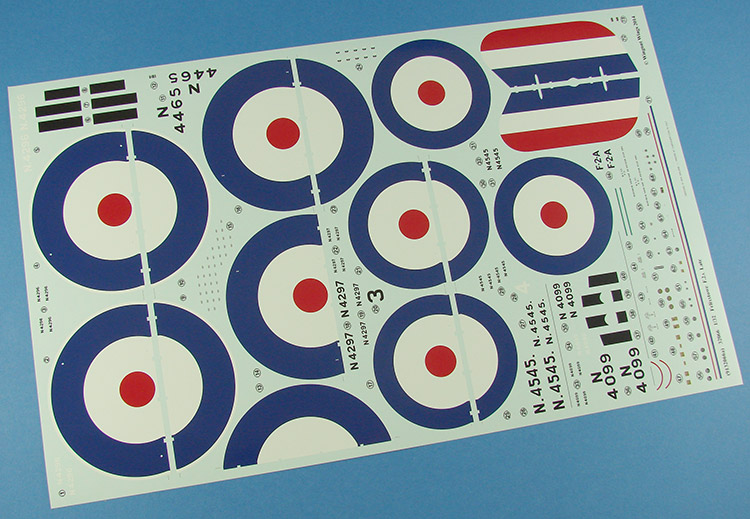 |
| g |
| One
large and two smaller sheets include all the national
markings and machine specific serials that you will
need, as well as a full suite of stencils, cockpit
instrument decals and various placards etc. Numerous
decals for fuel piping are supplied too. Decals are also
included for the rudder, although on a machine of this
size, I feel quite tempted to actually airbrush this. |
|
| g |
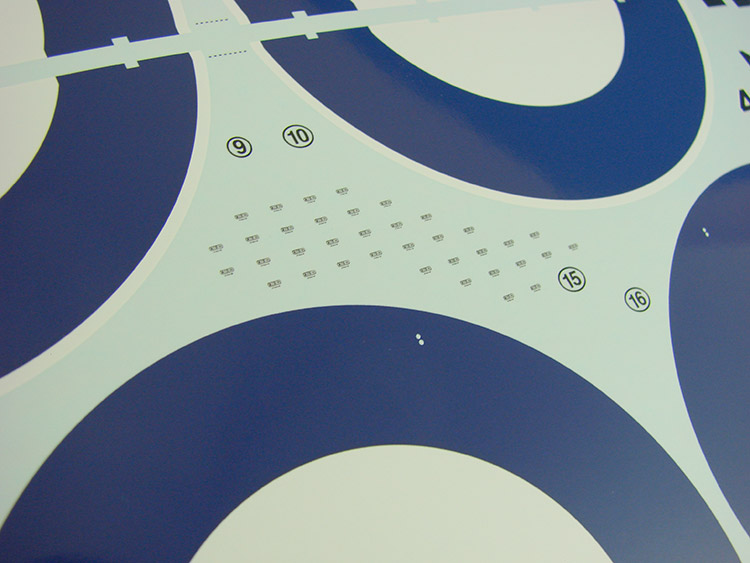 |
 |
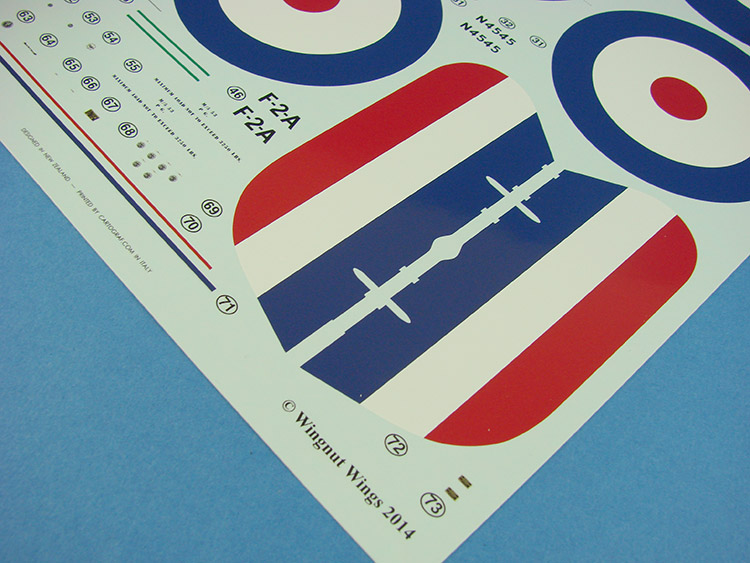 |
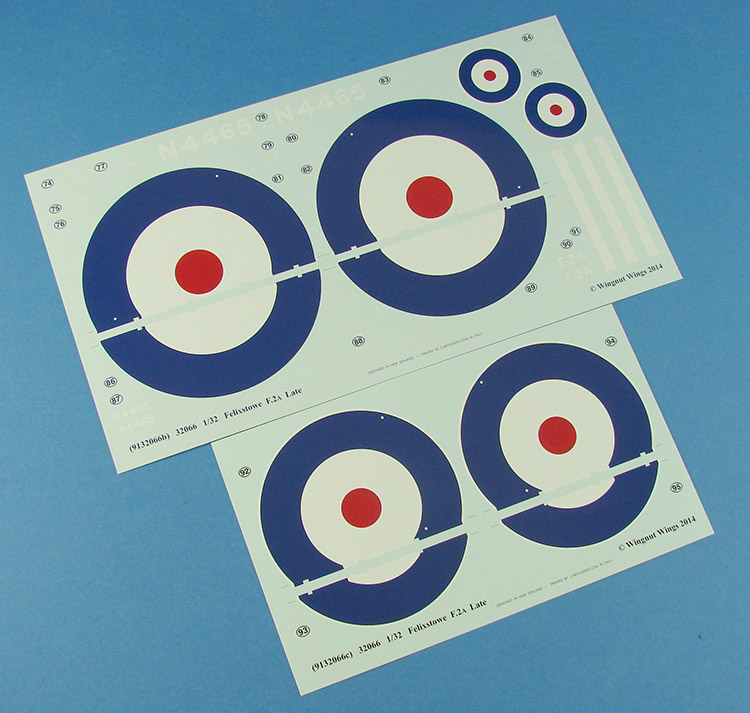 |
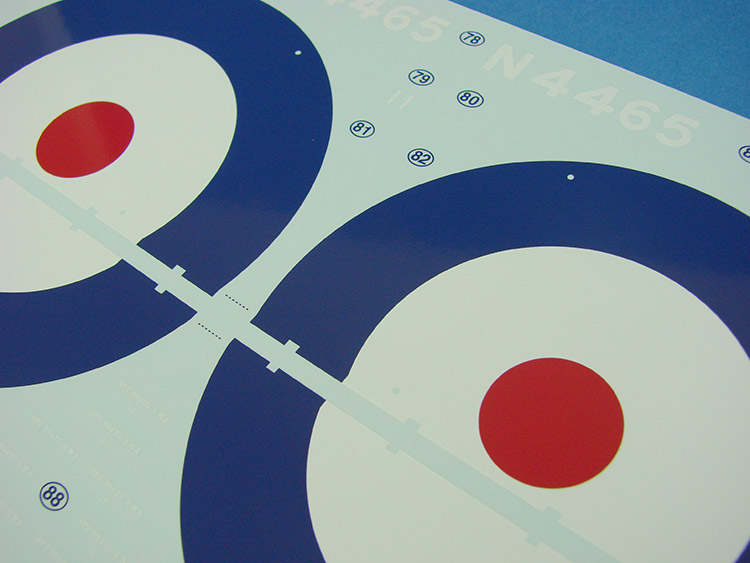 |
| g |
Printing is by Cartograf, and is solid, of authentic
colour, and has minimal carrier film. They are also nice
and thin, as well as having perfect register. As I said
earlier, the disruptive camo bars etc. will have to be
masked and airbrushed by the builder. There are FIVE
schemes supplied, and they are:
-
Felixstowe F.2a N4296, Saunders built, Felixstowe,
late 1918.
-
Felixstowe F.2a N4297, Saunders built, Felixstowe,
November 1918.
-
Felixstowe F.2a N4545, AMC/May, Harden & May built,
230 Sqn RAF, Felixstowe, August 1918.
-
Felixstowe F.2a N4099, Saunders built, Felixstowe,
late 1918.
-
Felixstowe F.2a N4465, Saunders built, Killingholme,
late 1918.
|
|
 |
 |
 |
 |
 |
| g |
 |
 |
| g |
|
Without a doubt, the thickest WNW instruction manual so
far, containing 34 pages, printed in high quality on
satin paper, and A4 in size. Starting with a little
history of the Felixstowe, and then a map of the parts,
all constructional sequences are then illustrated in
WNW's usual style of quasi-drawn and shaded images which
are ultra-easy to follow, and use blue ink to denote
newly added parts. Sections are then illustrated in full
colour, for your painting reference. Paint codes are
supplied for Tamiya and Humbrol paints, and FS codes are
also supplied. For rigging, numerous drawings are
provided, showing the various cable runs in different
coloured ink. WNW don't supply any turnbuckles, so you
will have to provide your own, should you wish to use
any. |
|
| g |
 |
 |
 |
 |
| g |
| To
help with reference, a good selection of period
photographs are also dispersed throughout the manual.
The latter
pages are taken over with Ronny Bar's fantastic colour
scheme profiles, annotated for decal placement.
Historical and colour notation is also supplied. |
|
| g |
 |
| g |
| I'm
still in absolute awe of this release. Such an amazingly
detailed and graceful looking model which will surely
dwarf anything you already have in your collection,
perhaps with the exception of an HK Models B-17!! This
kit really has it all, and despite hearing a few
criticisms of the price when it was announced, I think
that in comparison with many current kits, this is very
reasonable in its cost. The Felixstowe is certainly a
longer term project than any other kit they've released
to date, perhaps with the exception of the Gotha. Kudos
to WNW too. Who would ever have thought we would see a
Felixstowe F.2a in 1:32? Never in a million
years........until now! |
|
| g |
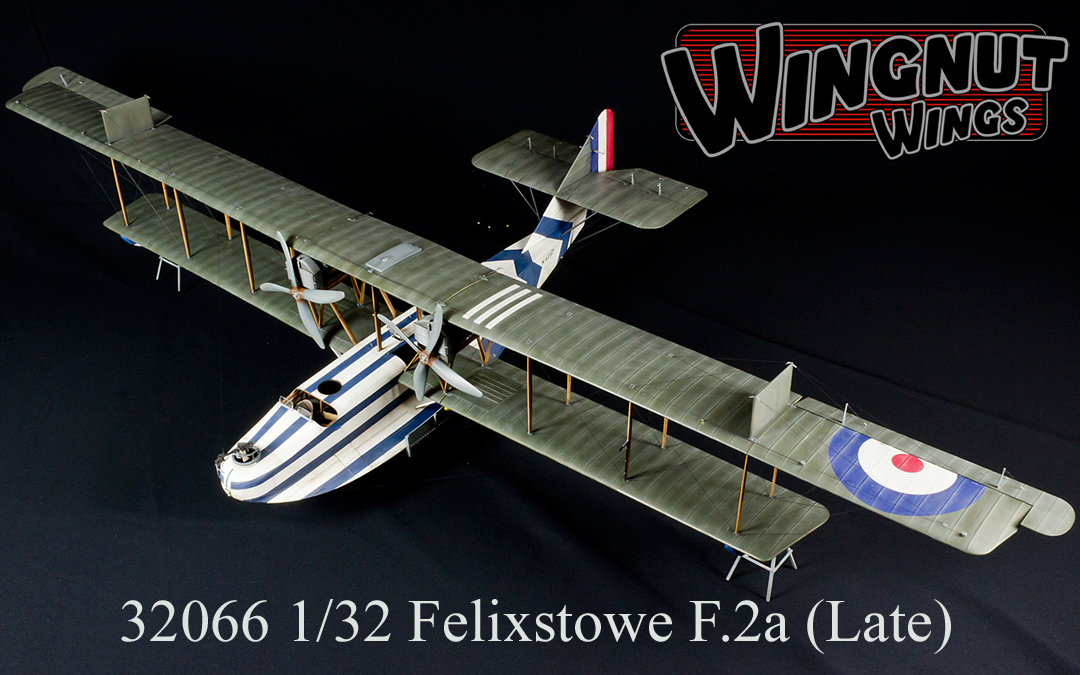 |
| g |
|
Unbelievably highly recommended. Just WOW!!!
My
sincere thanks to Wingnut Wings for
providing this review sample. To purchase directly,
click
THIS
link.
James
Hatch |
|
| g |

























